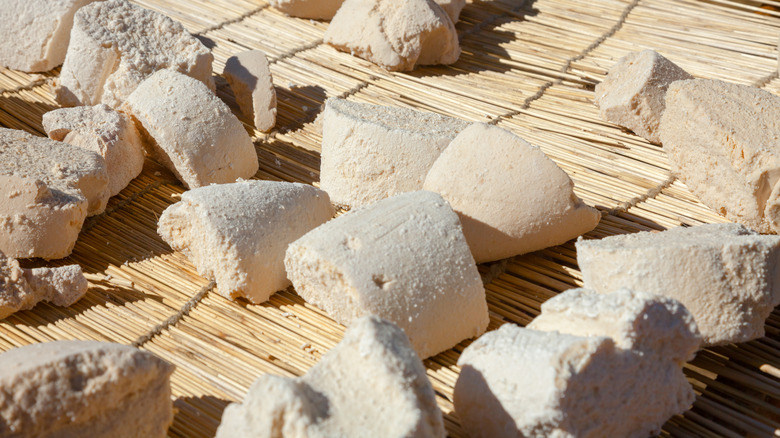The Importance Of Kashk In Persian Cuisine
Every cuisine has a handful of ingredients that serve as the backbone of a wide range of dishes. You'd be hard-pressed to enter a traditional French kitchen that's short on Dijon mustard, vinegar, fine sea salt, and pounds of butter (per Leonce Chenal). An Italian larder will reliably stock tinned fish, olive oil, canned tomatoes, lemons, and garlic (per Scordo). Countless Japanese recipes rely on a base of soy sauce, sake, Mirin, and rice vinegar (per Just One Cookbook).
Persian cooking, though varied by region, is no exception. Candice Walker, who celebrates her Persian heritage on her food blog Proportional Plate, lists ghand (also known as "broken sugar"), sabzi herb blends, rose water, and pomegranate molasses as a few Persian pantry staples. Central to that list is kashk, a dairy product that Walker describes as "a form of dried buttermilk." It comes in a variety of forms, including dried (pictured above) and a paste-like version that resembles yogurt. Here's how it's made, and why it's so essential in Persian cooking.
The art of preservation
Iranian Canadian cookbook author Naz Deravian, the author of the food blog Bottom of the Pot and the cookbook of the same name, grew up hearing that kashk is an "acquired taste." It was also hard to come by in her childhood home of Vancouver in the early 1980s, often leaving her mother with no choice but to use yogurt or sour cream in its place. But with the "advent of technology and globalization," as Deravian puts it, ingredients like kashk have become easier to find in North American grocery stores.
Deravian cites fellow recipe developer and The Guardian contributor Yotam Ottolenghi, who broadly defines the ingredient (which also goes by the name kishk, jameed, and tarhana) as a product of fermented yogurt, milk, or whey that appears in Iranian, Turkish, Balkan, and Arab cuisines. The process of making kashk begins on the heels of the summer wheat harvest, when bulgar (which is "made by boiling, drying and crushing the grain") is mixed with yogurt and left to dry in the sun.
"To understand Iranian kashk is to appreciate the centuries-old art of preservation in Iranian cuisine," writes Deravian in The Washington Post. She explains that, prior to modern refrigeration, shepherds in Iran turned to it as a means of preserving the gallons of milk that would otherwise spoil on their long journeys.
The dairy ferment adds a distinct tang
In its final form, kashk can help thicken soups and add a unique tangy flavor to all kinds of dishes. If you can't find it near you, Yotam Ottolenghi notes that a version of kashk can be made at home by mixing sour cream or crème fraîche with grated parmesan and a few "pulverized" anchovies. Writing for Bottom of the Pot, Naz Deravian recalls her family using it in aash-e reshteh, or aush reshteh, a green bean and noodle soup traditionally served on Noruz, the Persian New Year.
Another popular use for it is in kashke bademjan, an eggplant dip. A recipe on the food blog Cooking With Ayeh, which features caramelized onions, likens it to baba ghanoush. In another recipe, Food & Wine contributor Naz Riahi applauds its "luscious texture and tart flavor." Ottolenghi, per The Guardian, also uses it in Muhammara, a lemony Levantine dip with a base of red bell peppers, garlic, and walnuts.


